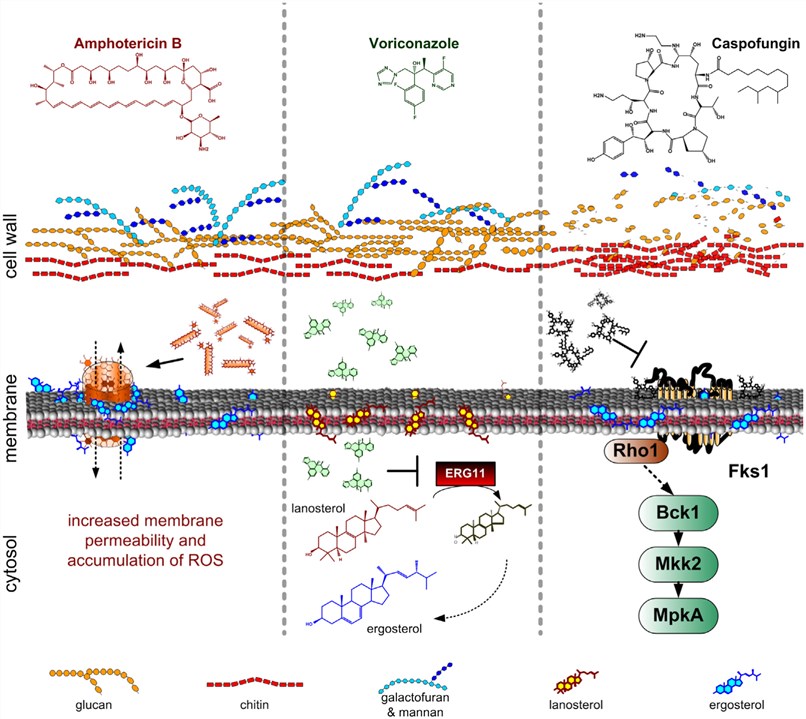Cell Wall Targets
As a leading service provider in the field of biological research and drug discovery, Creative Biolabs is confident to provide a full range of antifungal drug discovery services including target identification and validation, Hit identification, Hit to lead, Lead optimization, and IND enabling for global customers around the world. Based on the professional team and advanced technology platforms, we have developed a complete and thorough protocol to identify and validate the potential drug targets related to the fungal cell wall.
Fungal Cell Walls
The fungal cell walls surround the fungal cell outside of the plasma membrane. In general, fungal cell wall consists of three layers and from inside out these are chitin, glucan, and proteins. Chitin is a polymer consisting mainly of unbranched chains of N-acetyl-D-glucosamine, extruded by the plasma membrane. It is the largest component of the wall. Glucans, a type of polysaccharide, function to cross-link chitin or chitosan polymers. β-glucans are glucose molecules linked via β-(1,3)- or β-(1,6)- bonds and provide rigidity to the cell wall while α-glucans are defined by α-(1,3)- and α-(1,4) bonds and function as part of the matrix.
The outermost of the cell wall is proteins, particular mannoproteins which are heavily glycosylated and function as enzymes necessary for cell wall synthesis and lysis in addition to as the structural proteins. Fungal cell walls can form a rigid, mechanical barrier on the surface of the protoplast and protect fungus from changes in osmotic pressure and other environmental stresses. They also act as a carrier of specific antigen characteristics of the particular cell or the site of various extracellular enzymes engaged in the exchange of nutrients and products of metabolism and the hydrolysis of cell wall components, thus participating in various metabolic activities. Hence the fungal cell wall is very important for fungi growth and survival.
Based on this information of fungal cell walls structure and biosynthesis, an antifungal drug can be developed against these essential components of cell walls or suppressing key enzymes during cell wall biosynthesis. Here are the potential targets targeting fungal cell wall.
Glucan is the major structural polysaccharide of the fungal cell wall, constituting approximately 50-60% of the wall by dry weight, thus providing an appealing target for antifungal drugs. Inhibition of glucan biosynthesis destroys the structure of cell wall thus suppressing fungi growth and survival. The glucans of the fungal cell wall are polymers composed of repeating glucose residues that are assembled into chains through a variety of chemical linkages. In the process of glucan synthesis, glucan synthases are key enzymes which can act as the attractive targets for antifungal drugs.
 Fig.1 Mode of actions of antifungal drugs commonly used against invasive and systemic Aspergillus fumigatus infection.1
Fig.1 Mode of actions of antifungal drugs commonly used against invasive and systemic Aspergillus fumigatus infection.1
GPI functions as the bridge that anchors many functional proteins to the plasma membrane. These GPI-anchored proteins may function as glycosylhydrolases, glycosyltransferases, and peptidases which are responsible for cell wall synthesis and remodeling. Therefore inhibition of GPI biosynthesis provides an attractive potential target for the development of antifungal drugs.
Chitin is a β(1,4)-linked homopolymer of N-acetylglucosamine that present in all known fungal pathogens and not in humans. Therefore inhibition of chitin synthesis has been suggested as an attractive target for antifungal drugs. For example, chitin synthase (CHS), an integral membrane enzyme, is the key regulator that catalyzes the transfer of N-acetylglucosamine from uridine diphosphate (UDP)-N-acetylglucosamine to a growing chitin chain in the process of chitin biosynthesis. Hence CHS inhibition can offer a target for antifungal drugs.
Mannoproteins are heavily glycosylated with chains rich in mannose. They are the major components of the fungal cell wall. Inhibition of mannoprotein biosynthesis can disrupt the mannoprotein outer layer of the cell wall and unmask the more immunogenic inner β-glucan layer. Thus mannoprotein biosynthesis also represents a target for the development of anti-fungal drugs.
Advantages in Creative Biolabs
- Advanced technology platform
- Extensive repertoires of pharmacological targets
- Experienced expert team
- Rapid and accurate screening protocol
- Low cost and high services
Creative Biolabs has years of experience in drug targets discovery. If you are interested in our antifungal drug discovery services, please contact us for more details.
Reference
- Valiante, V.; et al. The Aspergillus fumigatus cell wall integrity signaling pathway: drug target, compensatory pathways, and virulence. Frontiers in Microbiology. 2015, 6:325. Distributed under Open Access license CC BY 4.0, without modification.
For Research Use Only.
